
The Most Filmed Streets in the United States

When choosing which neighborhood to buy your home in, you could end up living on a street that made it to the silver screen. That’s why American Home Shield has analyzed location data from IMDb to uncover the most filmed streets in the United States.
America has sold itself to the world through the cinema screen. And, for half a century, location shooting has been the common way of doing so, even in the big studio world of Hollywood. But, while a powerful location can turn a pedestrian movie into a runaway classic, many of the same places get used again and again.
In fact, our study found that nine out of the ten most filmed streets are in NYC or LA. And 44 out of the top 50 are in the states of California or New York. However, we also found that many other cities have their own superstar streets.
Whether you’re wondering how screen-friendly is your street or you’re in the process of researching a neighborhood before buying a house, make sure to explore our interactive map to guide you through the America you see in the movies – without make-up.
Scroll on for film location maps of LA, NYC, San Francisco, Chicago, and New Orleans.
Hollywood Boulevard is the Most Filmed Street in the US
The fortunes of Hollywood Boulevard have risen, fallen, and re-risen with those of the big Hollywood studios. Today, the street has the storied patina of an aged character actor. Renamed from ‘Prospect Avenue’ at the dawn of Hollywood history, the boulevard was soon lined with picture palaces and glamorous stores, becoming ‘seedy’ and ‘funky’ in the 1970s – right as New Hollywood drew filmmakers out of the studio and into the real world.
So, across the years, the Boulevard has offered not just convenience for location scouts but a ripening charisma. And that’s to say nothing of its secret alleys.
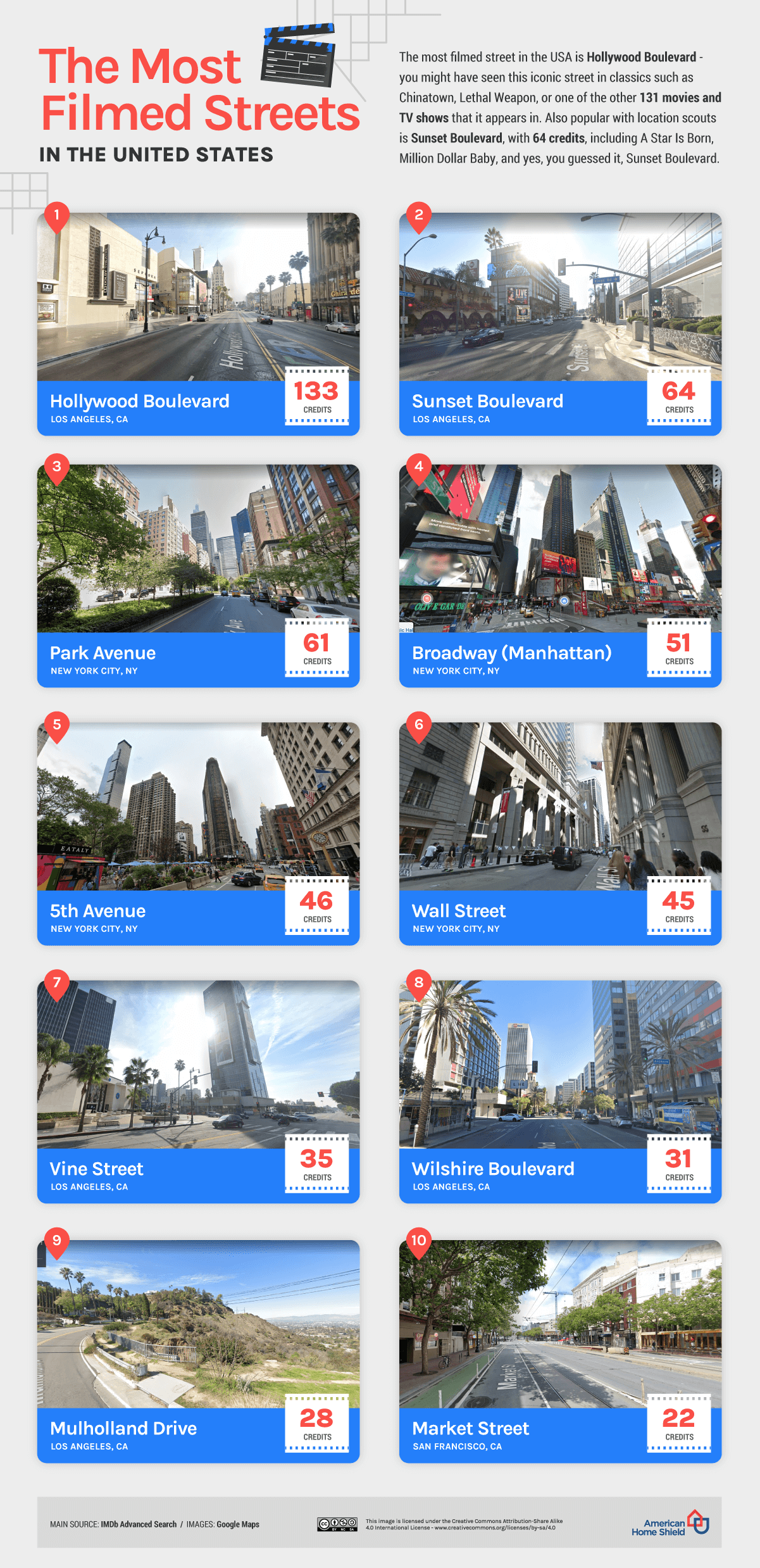
The most filmed street outside of California is Park Avenue in New York. From The Naked City to The Devil’s Advocate, the street’s filmography “dramatically chronicle[s] the Post War architectural transformation of Park Avenue.”
Skyscrapers and fancy hotels evoke the giddy glamour of American wealth, while the poor who live in their shadows have their own compelling stories. Somewhere between are the ‘everyman’ buildings, where countless movie characters have worked – such as 101 Park Avenue, which looks kind of normal but on a dramatic Hollywood scale.
Thinking about coverage?
Sounds like a plan. Find the warranty that fits you best.
Mulholland Drive and Sunset Boulevard Among LA’s Regular Locations
Hollywood filmmaking can be something of a closed-loop ring road. The movies make the glamour that warps or fades until it becomes interesting enough to be worth its own movie. Two of cinema’s most celebrated Hollywood-themed pictures borrow the names of their real-life locations. In Sunset Boulevard (1950), a faded starlet plots her triumphant return to the screen from her mansion on the eponymous street – known for its tinsel-town glamour since the early days of Hollywood.
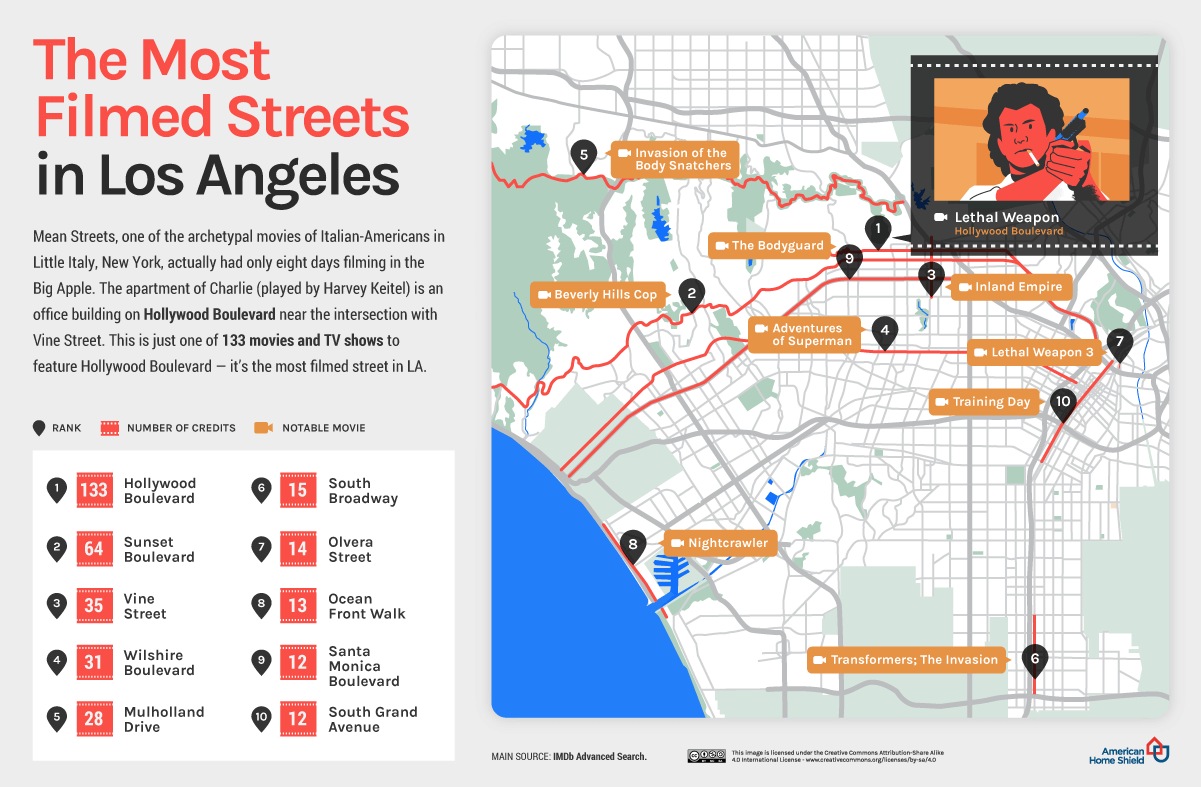
Mulholland Drive is the location of the car crash that kickstarts the splitting plot of David Lynch’s 2001 movie of the same name. The film tells the tale of a hopeful young actress’s arrival on the Hollywood scene, and her descent into the community’s dark underbelly.
Park Avenue, Broadway Lead Cast of Frequent New York Locations
Like LA, some of New York City’s most used locations have also had movies named after them. Wall Street, as the hub of the New York Stock Exchange, has headline films including Wall Street (1987) and The Wolf of Wall Street (2013). It has also symbolized wealth, greed, or corruption in pictures such as Jumpin’ Jack Flash (1986) and The Devil’s Advocate (1997).
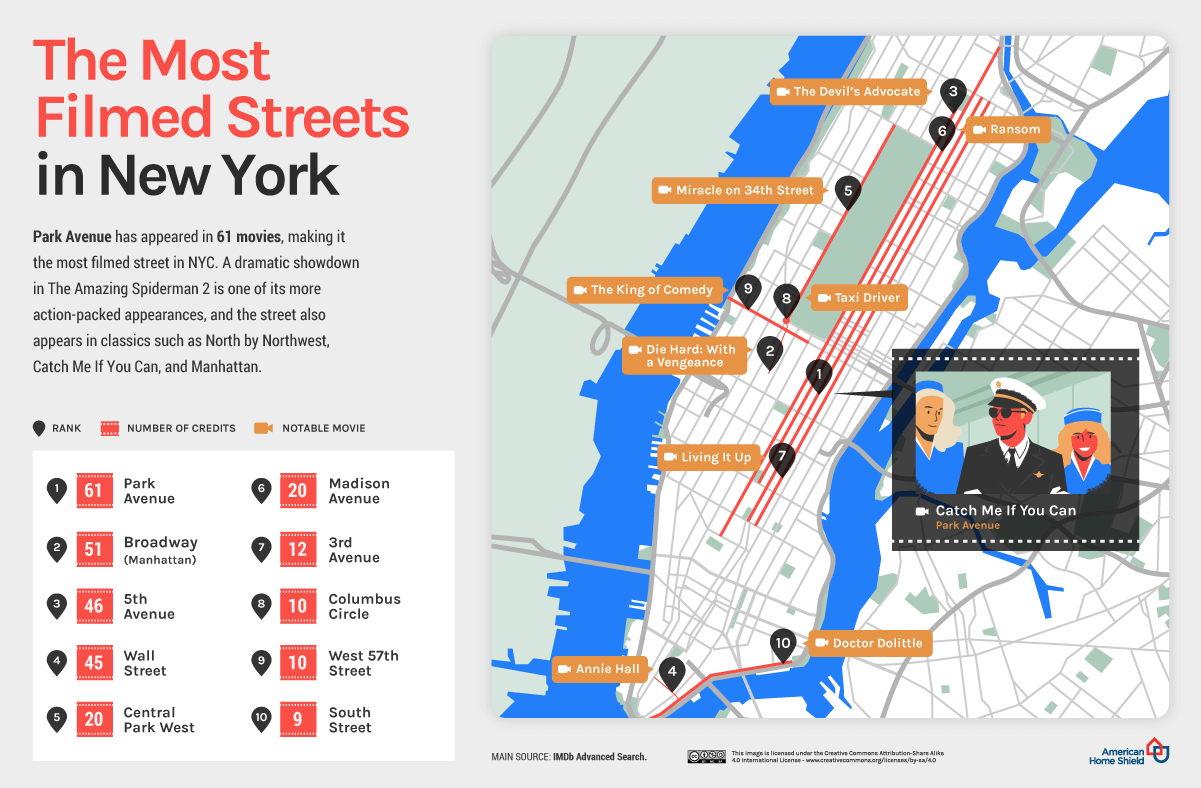
Park Avenue is overall the most used location in New York City, with 61 IMDb credits. Broadway in Manhattan is not far behind, with 51. While Sunset Boulevard instantly conjures the glamour of filmmaking in LA, Broadway is shorthand for the drama, duplicity, and egos of east coast theater. Michael Keaton’s jittery turn as a faded star/director in Birdman drags the viewer on an actor’s tour of New York in what appears to be a single long take, with his Broadway production as its hub.
Market Street is San Francisco’s Most Popular Movie Location
Market Street is a major artery of San Francisco, and its vibrant daily life has won it roles in 22 movies – more than any other SF location. James Bond made a daring escape along the street in a fire engine in A View To A Kill (1985), but a more touching tribute can be found in this 1906 reel from just days before the Great San Francisco Earthquake.
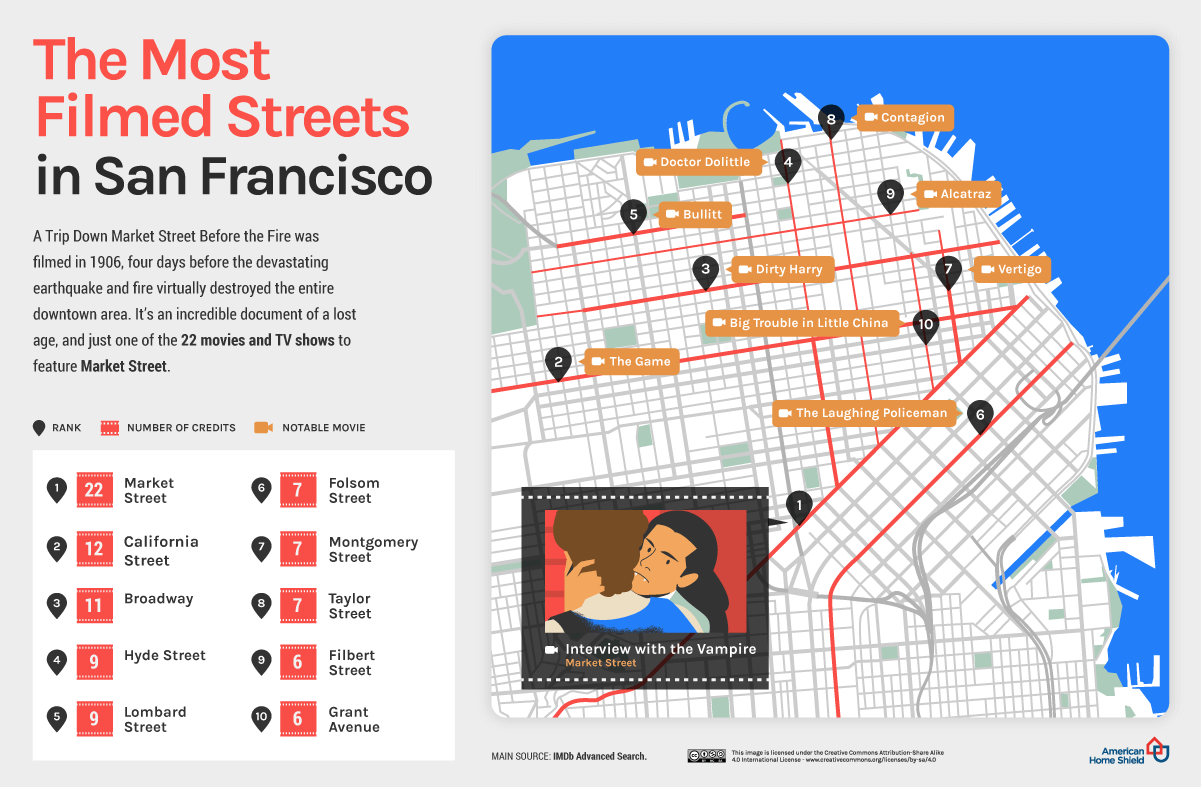
The dramatic hills of Frisco offer a giddy psychological alternative to glamorous LA and gritty NYC. Perhaps the city’s most celebrated appearance is through the rear window of James Stewart’s car in Hitchcock’s Vertigo (1958) – and the action turns around the hero’s encounter with Madeleine at Ernie’s on Montgomery Street, SF’s seventh most credited road.
Chicago’s Crime Stories Favor Lower Wacker Drive
Who said Gotham is NYC? Christopher Nolan’s Batman lives in a very thinly disguised Chicago, cast both for its modern look and its troubled history. Batman Begins and The Dark Knight both credit the top Chicago location, Lower Wacker Drive, benefitting from “its cavernous underground space kept in a kind of perpetual gloaming by artificial light.”
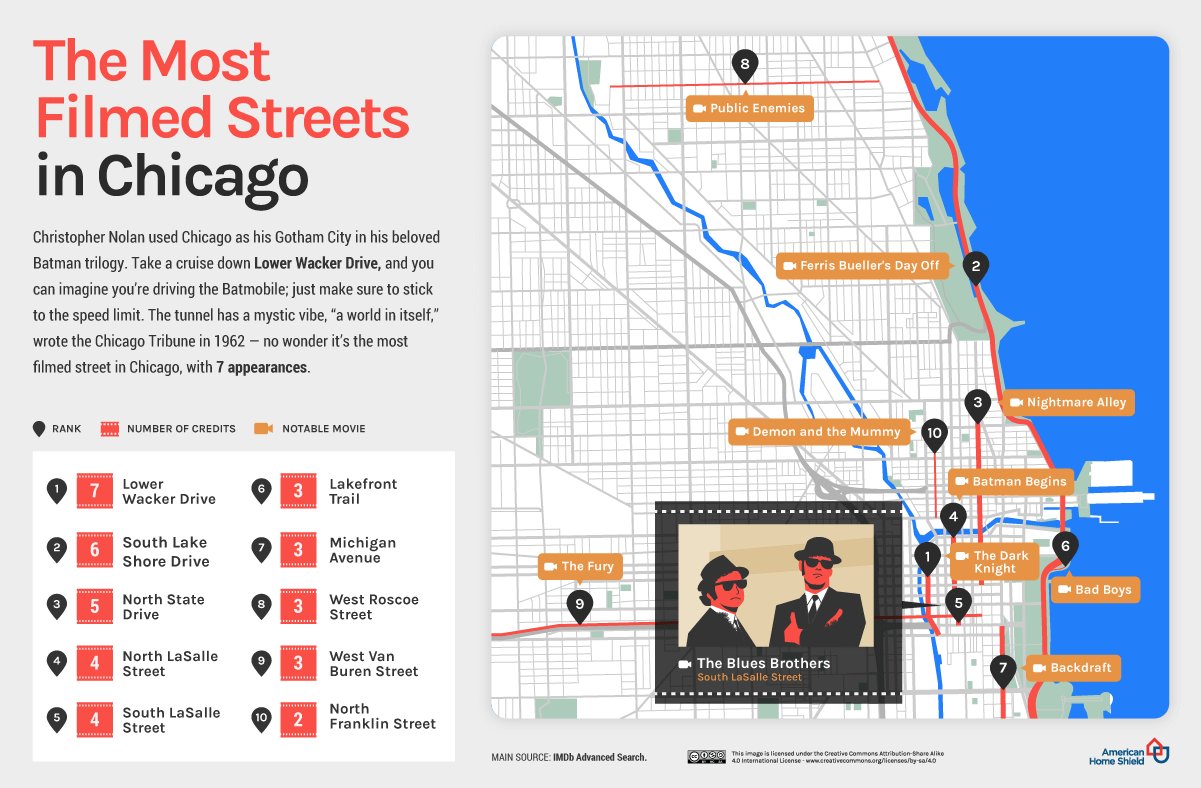
Chicago’s long association with career criminals (clown-themed or otherwise) stretches back past the Batman reboot to the Prohibition mobster era of Al Capone. Brian De Palma’s 1987 take on Capone’s downfall, The Untouchables, made use of real-life locations such as the City National Bank and Trust Company Building, where Eliot Ness and his team lead a liquor raid on a post office.
Bourbon Street is the Most Filmed in New Orleans
Bourbon Street is the throbbing heart of New Orleans’ music life and has notched up credits in fiction films and live shows alike. But its most famous on-screen appearance is an (admittedly raucous) funeral parade – the one in which the ‘deceased’ is murdered and packed up in a coffin along the way.
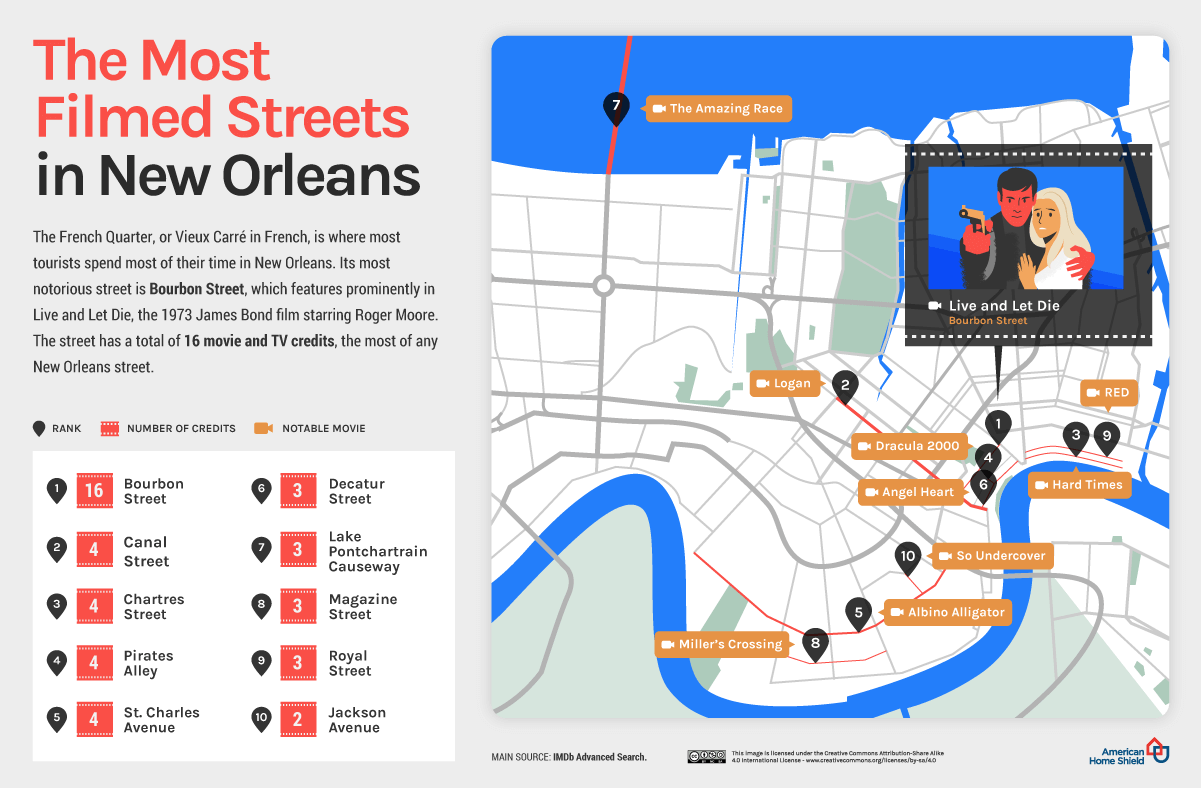
Canal Street, Chartres Street, and Pirates Alley total four credits each. Paul Schrader’s 1982 Cat People remake relocates the tale from New York to New Orleans, situating the Gallier siblings’ home on the corner of Chartres and Esplanade.
Location vs. Studio
With the exception of the Western genre – which thrived on America’s natural beauty and turned natural light into box office bucks – most pre-war mainstream filmmaking was done in a controlled studio environment. Why? Cameras were heavy and immobile. The real world is noisy and has unpredictable weather. Filmmakers could control every aesthetic detail on set, and audiences were not yet cynical enough to demand hi-res realism.
But while a studio set is ideal for imaginary worlds, location filmmaking delivers its own gifts – the real-life buzz of the street, the weather-worn character of the buildings, and surprising encounters with natural light and local non-actors. Check out our full data below to see where they’re most found!
METHODOLOGY & SOURCES
Using IMDb Advanced Search, we selected the movies from 01.01.1900 to 31.12.2020 that had data about filming locations. Then using Google Geocoding API, we cleaned the locations and kept only routes (streets, avenues, etc.) and intersections (for which we counted both crossing roads).
Finally, we collated the total number of combined movie and TV credits for each street. We only looked at instances where the street was filmed, rather than a landmark or location located on a specific street.
We merged Santa Monica Boulevard and Sunset Boulevard in West Hollywood with the same streets in Los Angeles.
AHS assumes no responsibility, and specifically disclaims all liability, for your use of any and all information contained herein.
Don't Worry. Be Warranty.
Have a plan for your home when things don't go according to plan
Shop Home Warranties

